Engelbert Mephu Nguifo
LIMOS, UCA
A comparative study of emotion recognition methods using facial expressions
Dec 05, 2022
Abstract:Understanding the facial expressions of our interlocutor is important to enrich the communication and to give it a depth that goes beyond the explicitly expressed. In fact, studying one's facial expression gives insight into their hidden emotion state. However, even as humans, and despite our empathy and familiarity with the human emotional experience, we are only able to guess what the other might be feeling. In the fields of artificial intelligence and computer vision, Facial Emotion Recognition (FER) is a topic that is still in full growth mostly with the advancement of deep learning approaches and the improvement of data collection. The main purpose of this paper is to compare the performance of three state-of-the-art networks, each having their own approach to improve on FER tasks, on three FER datasets. The first and second sections respectively describe the three datasets and the three studied network architectures designed for an FER task. The experimental protocol, the results and their interpretation are outlined in the remaining sections.
Explainable classification of astronomical uncertain time series
Sep 28, 2022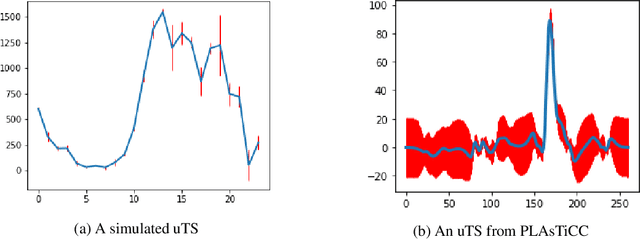


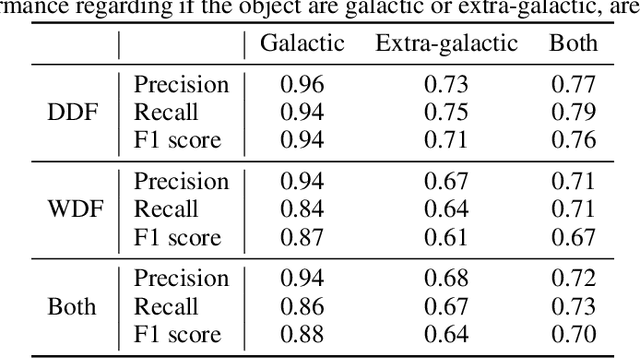
Abstract:Exploring the expansion history of the universe, understanding its evolutionary stages, and predicting its future evolution are important goals in astrophysics. Today, machine learning tools are used to help achieving these goals by analyzing transient sources, which are modeled as uncertain time series. Although black-box methods achieve appreciable performance, existing interpretable time series methods failed to obtain acceptable performance for this type of data. Furthermore, data uncertainty is rarely taken into account in these methods. In this work, we propose an uncertaintyaware subsequence based model which achieves a classification comparable to that of state-of-the-art methods. Unlike conformal learning which estimates model uncertainty on predictions, our method takes data uncertainty as additional input. Moreover, our approach is explainable-by-design, giving domain experts the ability to inspect the model and explain its predictions. The explainability of the proposed method has also the potential to inspire new developments in theoretical astrophysics modeling by suggesting important subsequences which depict details of light curve shapes. The dataset, the source code of our experiment, and the results are made available on a public repository.
Expert Opinion Elicitation for Assisting Deep Learning based Lyme Disease Classifier with Patient Data
Aug 30, 2022



Abstract:Diagnosing erythema migrans (EM) skin lesion, the most common early symptom of Lyme disease using deep learning techniques can be effective to prevent long-term complications. Existing works on deep learning based EM recognition only utilizes lesion image due to the lack of a dataset of Lyme disease related images with associated patient data. Physicians rely on patient information about the background of the skin lesion to confirm their diagnosis. In order to assist the deep learning model with a probability score calculated from patient data, this study elicited opinion from fifteen doctors. For the elicitation process, a questionnaire with questions and possible answers related to EM was prepared. Doctors provided relative weights to different answers to the questions. We converted doctors evaluations to probability scores using Gaussian mixture based density estimation. For elicited probability model validation, we exploited formal concept analysis and decision tree. The elicited probability scores can be utilized to make image based deep learning Lyme disease pre-scanners robust.
Uncertain Time Series Classification With Shapelet Transform
Feb 03, 2021
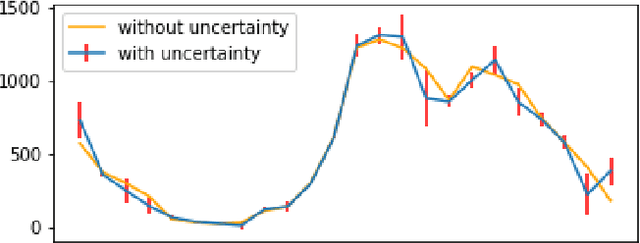


Abstract:Time series classification is a task that aims at classifying chronological data. It is used in a diverse range of domains such as meteorology, medicine and physics. In the last decade, many algorithms have been built to perform this task with very appreciable accuracy. However, applications where time series have uncertainty has been under-explored. Using uncertainty propagation techniques, we propose a new uncertain dissimilarity measure based on Euclidean distance. We then propose the uncertain shapelet transform algorithm for the classification of uncertain time series. The large experiments we conducted on state of the art datasets show the effectiveness of our contribution. The source code of our contribution and the datasets we used are all available on a public repository.
Discovering Frequent Gradual Itemsets with Imprecise Data
May 22, 2020



Abstract:The gradual patterns that model the complex co-variations of attributes of the form "The more/less X, The more/less Y" play a crucial role in many real world applications where the amount of numerical data to manage is important, this is the biological data. Recently, these types of patterns have caught the attention of the data mining community, where several methods have been defined to automatically extract and manage these patterns from different data models. However, these methods are often faced the problem of managing the quantity of mined patterns, and in many practical applications, the calculation of all these patterns can prove to be intractable for the user-defined frequency threshold and the lack of focus leads to generating huge collections of patterns. Moreover another problem with the traditional approaches is that the concept of gradualness is defined just as an increase or a decrease. Indeed, a gradualness is considered as soon as the values of the attribute on both objects are different. As a result, numerous quantities of patterns extracted by traditional algorithms can be presented to the user although their gradualness is only a noise effect in the data. To address this issue, this paper suggests to introduce the gradualness thresholds from which to consider an increase or a decrease. In contrast to literature approaches, the proposed approach takes into account the distribution of attribute values, as well as the user's preferences on the gradualness threshold and makes it possible to extract gradual patterns on certain databases where literature approaches fail due to too large search space. Moreover, results from an experimental evaluation on real databases show that the proposed algorithm is scalable, efficient, and can eliminate numerous patterns that do not verify specific gradualness requirements to show a small set of patterns to the user.
Classification des S{é}ries Temporelles Incertaines par Transformation Shapelet
Dec 11, 2019


Abstract:Time serie classification is used in a diverse range of domain such as meteorology, medicine and physics. It aims to classify chronological data. Many accurate approaches have been built during the last decade and shapelet transformation is one of them. However, none of these approaches does take data uncertainty into account. Using uncertainty propagation techiniques, we propose a new dissimilarity measure based on euclidean distance. We also show how to use this new measure to adapt shapelet transformation to uncertain time series classification. An experimental assessment of our contribution is done on some state of the art datasets.
Extracting Frequent Gradual Patterns Using Constraints Modeling
Mar 20, 2019
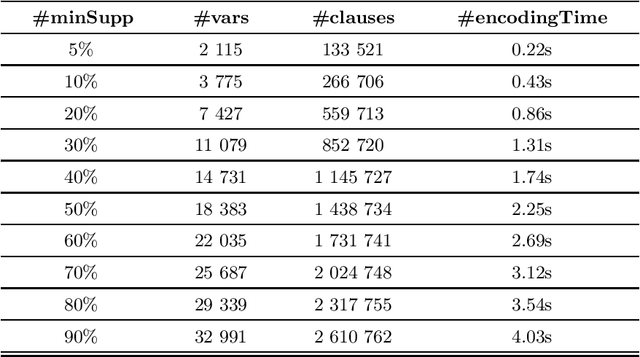
Abstract:In this paper, we propose a constraint-based modeling approach for the problem of discovering frequent gradual patterns in a numerical dataset. This SAT-based declarative approach offers an additional possibility to benefit from the recent progress in satisfiability testing and to exploit the efficiency of modern SAT solvers for enumerating all frequent gradual patterns in a numerical dataset. Our approach can easily be extended with extra constraints, such as temporal constraints in order to extract more specific patterns in a broad range of gradual patterns mining applications. We show the practical feasibility of our SAT model by running experiments on two real world datasets.
Towards Learned Clauses Database Reduction Strategies Based on Dominance Relationship
May 31, 2017



Abstract:Clause Learning is one of the most important components of a conflict driven clause learning (CDCL) SAT solver that is effective on industrial instances. Since the number of learned clauses is proved to be exponential in the worse case, it is necessary to identify the most relevant clauses to maintain and delete the irrelevant ones. As reported in the literature, several learned clauses deletion strategies have been proposed. However the diversity in both the number of clauses to be removed at each step of reduction and the results obtained with each strategy creates confusion to determine which criterion is better. Thus, the problem to select which learned clauses are to be removed during the search step remains very challenging. In this paper, we propose a novel approach to identify the most relevant learned clauses without favoring or excluding any of the proposed measures, but by adopting the notion of dominance relationship among those measures. Our approach bypasses the problem of the diversity of results and reaches a compromise between the assessments of these measures. Furthermore, the proposed approach also avoids another non-trivial problem which is the amount of clauses to be deleted at each reduction of the learned clause database.
A multiple instance learning approach for sequence data with across bag dependencies
Jan 30, 2016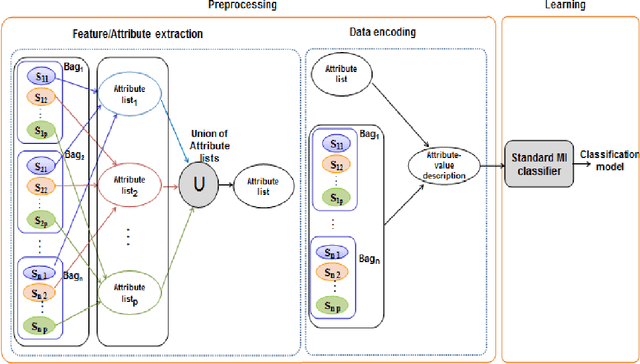
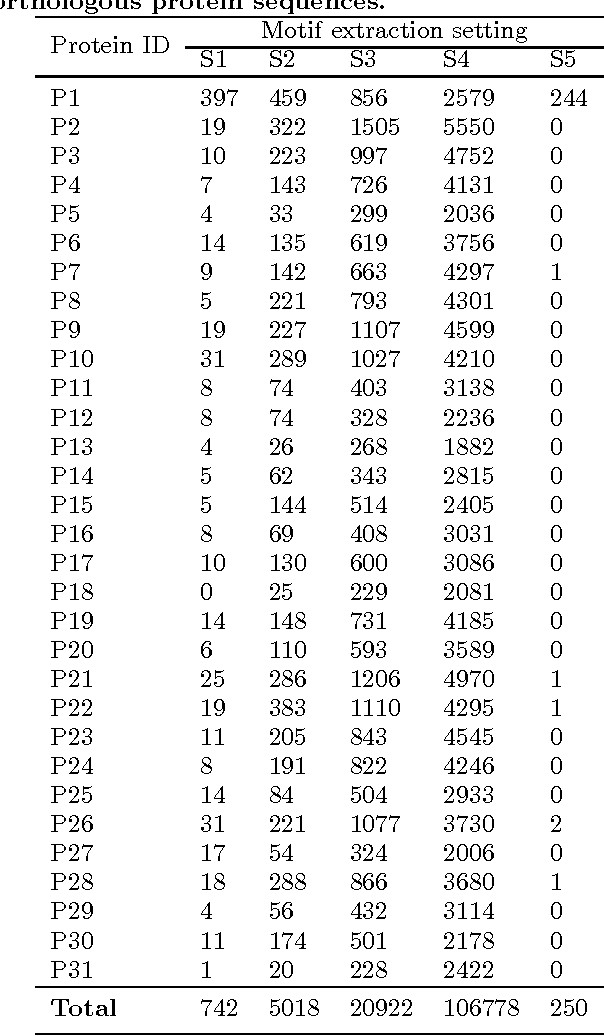

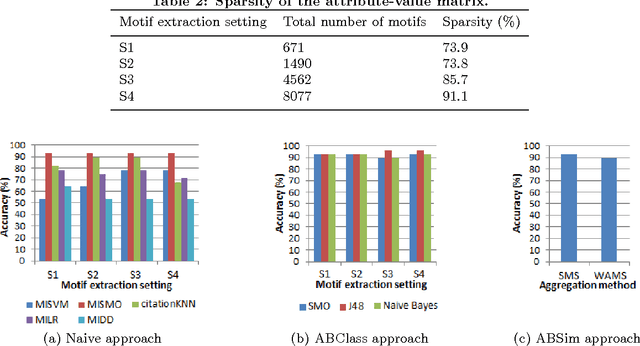
Abstract:In Multiple Instance Learning (MIL) problem for sequence data, the learning data consist of a set of bags where each bag contains a set of instances/sequences. In many real world applications such as bioinformatics, web mining, and text mining, comparing a random couple of sequences makes no sense. In fact, each instance of each bag may have structural and/or temporal relation with other instances in other bags. Thus, the classification task should take into account the relation between semantically related instances across bags. In this paper, we present two novel MIL approaches for sequence data classification: (1) ABClass and (2) ABSim. In ABClass, each sequence is represented by one vector of attributes. For each sequence of the unknown bag, a discriminative classifier is applied in order to compute a partial classification result. Then, an aggregation method is applied to these partial results in order to generate the final result. In ABSim, we use a similarity measure between each sequence of the unknown bag and the corresponding sequences in the learning bags. An unknown bag is labeled with the bag that presents more similar sequences. We applied both approaches to the problem of bacterial Ionizing Radiation Resistance (IRR) prediction. We evaluated and discussed the proposed approaches on well known Ionizing Radiation Resistance Bacteria (IRRB) and Ionizing Radiation Sensitive Bacteria (IRSB) represented by primary structure of basal DNA repair proteins. The experimental results show that both ABClass and ABSim approaches are efficient.
Towards a constructive multilayer perceptron for regression task using non-parametric clustering. A case study of Photo-Z redshift reconstruction
Dec 17, 2014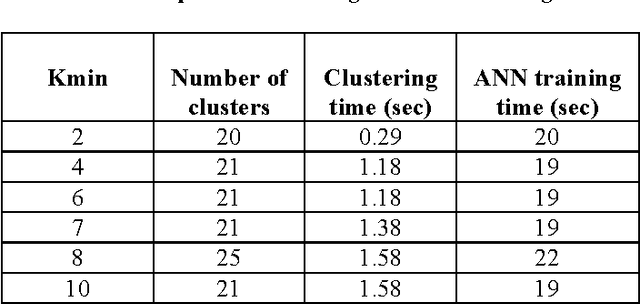
Abstract:The choice of architecture of artificial neuron network (ANN) is still a challenging task that users face every time. It greatly affects the accuracy of the built network. In fact there is no optimal method that is applicable to various implementations at the same time. In this paper we propose a method to construct ANN based on clustering, that resolves the problems of random and ad hoc approaches for multilayer ANN architecture. Our method can be applied to regression problems. Experimental results obtained with different datasets, reveals the efficiency of our method.
 Add to Chrome
Add to Chrome Add to Firefox
Add to Firefox Add to Edge
Add to Edge